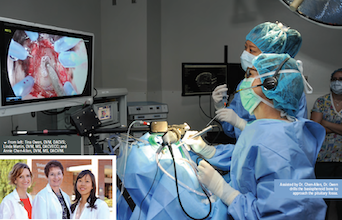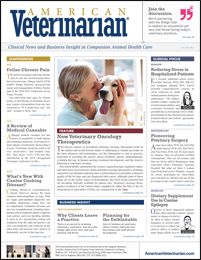Pioneering Pituitary Surgery
Three women on 1 superb surgical team are changing the lives of dogs and cats with pituitary tumors.

Annie Chen-Allen, DVM, MS, DACVIM; Linda Martin, DVM, MS, DACVECC; and Tina Owen, DVM, DACVS, have much in common. They are all board certified veterinarians, they are all women, and they are all on staff at Washington State University (WSU) Veterinary Teaching Hospital. But what set these 3 women apart from their peers? Pituitary surgeon Dr. Owen, neurologist Dr. Chen-Allen, and criticalist Dr. Martin lead one of the few teams in the country that is removing pituitary tumors surgically from dogs and cats. Dr. Owen has performed transsphenoidal hypophysec­tomy on nearly 60 animals in the past 8 years.
Each year Cushing disease (hyperadrenocorticism) is diagnosed in approximately 100,000 dogs, about 85% of which have a pituitary tumor. Surgery is the gold standard for treating pituitary tumors in people— and in dogs and cats in some parts of Europe—but in the United States medication and radiation tend to be the recommended routes of treatment.
In addition to performing about 1 transsphenoi­dal hypophysectomy procedure per month, the group published 4 papers on the topic last year. American Veterinarian® spoke with these pioneers about how they approach the surgical excision of pituitary tu­mors in dogs and cats and what they want the vet­erinary community to know about making surgery one of the first lines of treatment.
What factors come into play in selecting treatment for patients with pituitary tumors?
Tina Owen, DVM, DACVS: Three treatment options exist for these patients: medical management, radi­ation therapy, and surgery. Which option is chosen depends on the owner and the patient. The owner must be willing to move forward with surgery, and he or she must understand the risks and complications associated with the procedure.
Linda Martin, DVM, MS, DACVECC: Surgical treatment is more expensive than either medical therapy or radiation. We find owners who are really interested in trying to achieve that potential cure for their pet and are willing to take some of the risks that are involved with surgery. Because of the expense, it does select for a certain group of owners who are able to provide that type of care.
Dr. Owen: In addition, the overall health of the animal, the infiltrative nature of the tumor, and the size of the tumor all make a difference in selecting the ideal treatment. There is more potential for neurologic signs with larger tumors.
Annie Chen-Allen, DVM, MS, DACVIM: The other factor to consider is what the tumor is doing to the patient— whether it’s causing endocrine signs or not—for exam­ple, if the patient has Cushing disease, diabetes, or acromegaly. When the pituitary tumor is functional, we tend to assume it is an adenoma. From a surgical standpoint, those tumors are going to be more easily removable because they are softer, so we feel we can better predict the tumor consistency in patients with functional disease as opposed to nonfunctional disease. When it’s nonfunctional, it could be a tumor other than an adenoma that may be more difficult to remove with surgery, with greater potential for complications.

What is transsphenoidal hypophysectomy, and when would it be the best treatment option?
Dr. Owen: Transsphenoidal hypophysectomy is the surgical removal of a pituitary tumor or the pitu­itary gland through the basisphenoid bone at the base of the skull. The surgery is very comparable between animals and humans. In people, the surgeon approaches the pituitary through the nose. In dogs and cats, the approach is a bit different because of the shape of the skull. We approach the tumor through the mouth and through the soft palate, to the basi­sphenoid bone.
The most common reason we would perform surgery on a dog is for pituitary-dependent Cushing disease. In cats, it’s acromegaly or overproduction of growth hormone due to a pituitary tumor.
Dr. Chen-Allen: In cats especially, we feel there is more of a push for surgery because when they’re acromegalic they often have insulin resistance that leads to uncontrolled diabetes mellitus. In those situations, there really is no good medical manage­ment. There’s not a drug you could give to control the diabetes successfully long-term, and so in that situ­ation surgery becomes a really good option because often we’re able to put them in diabetic remission to cure their diabetes and also cure their acromegaly.
Dr. Owen: Surgery allows us to diagnose by histopa­thology. No other treatment option provides tumor tissue to be able to make a diagnosis, which can help plan postoperative care and also prognosticate. Surgery also allows us to decompress the tumor, so we can gain rapid control of the neurologic signs and endocrine signs if it’s a functional tumor.
It also allows us the potential for cure. Although we don’t know the definition of cure in animals, people are considered cured following pituitary tumor surgery if they have no endocrine or neuro­logic relapse for 5 years.
What would you like other veterinarians to know about this surgery?
Dr. Owen: We know from the literature and from experience that success rates with surgery are higher when treating smaller tumors. So we’re trying to ed­ucate the public and the veterinary community that we need to see these tumors when they’re smaller.
Also, acromegaly in cats can be treated with radiation, but it takes a long time to gain control of the endocrine signs and a long time to try and remove the tumor when it’s much smaller.
Dr. Chen-Allen: The earlier surgery is performed, the better the chance is to remove the tumor completely and the lower the risk of complications. We advocate brain imaging as part of the initial workup when cats and dogs are diagnosed with acromegaly and Cushing disease. This will help owners decide in the initial stages—before it’s too late—whether surgery is an option. If we can catch these tumors when they’re smaller, before the patient becomes neurologic, then we have a better chance at a successful outcome.
Dr. Owen: The success rate of pituitary surgery is very similar in people and animals—80% to 90% of people, dogs, and cats achieve disease remission with surgery. There is about a 25% rate of recur­rence, usually because small remnants of tumor are left behind.
If a tumor recurs, the treatment could be a combi­nation of things. We could repeat the surgery— although we don’t do that very often—they can have radiation as a follow-up treatment or, depending on the tumor type, chemotherapy may be potentially helpful. This is where getting tissue from the tumor, submitting it for histopathology, and getting a diag­nosis can really help with follow-up treatments or to plan for subsequent care in case of recurrence.
How does your team approach at WSU shape the care you are able to provide?
Dr. Martin: I think the team approach is very helpful when it comes to doing pituitary surgery. The surgery itself is a very difficult, and Dr. Owen has trained for many years to provide this service. She is the one who initially discusses the surgery with the clients or referring veterinarians. Between them, they will decide whether the animal is a good surgical candidate.
If the procedure is planned, the clients come in and meet the team. Dr. Chen-Allen is our neurologist and assists Dr. Owen with the surgery—she is her right-hand woman, so to speak. As a group we try to help each other whenever we can. I am not a surgeon, but I am in surgery assisting with anesthesia and patient care, and helping Drs. Owen and Chen-Allen with anything they might need.
Once the surgery is finished, the ball is in my hands. I manage the postoperative care, which includes moni­toring the patient and overseeing the tests that need to be completed. Of course, I receive a lot of assistance from other team members. It’s by far not just the 3 of us; we have a lot of support. Because we work well together as a team we can provide the best care possible for our clients and our patients.
Dr. Owen: I think the owners are very appreciative because the 3 of us are there to explain our respective roles when clients come in for the initial consult, and we are there throughout the pet’s care at the hospital, which can be 7 to 10 days or so. When pet owners see a cohesive team working together I think they are much more comfortable with their decision and know that their animals are in very good care.
